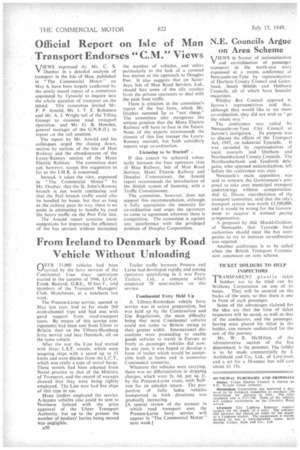From Ireland to Denmark by Road Vehicle Without Unloading
Page 8

If you've noticed an error in this article please click here to report it so we can fix it.
OVF.R 33,000 vehicles had been V./carried by the ferry services of the Continental Line since operations started in the autumn of 1946, Lt.-Col. Frank Bustard, 0.B.E., M.Inst.T., told members of the Transport Managers' Club, Manchester, at a luncheon last week.
The Preston-Larne service, opened in May last year, had so far made 260 cross-channel trips and had met with good support froth Mad-transport users. By means of this service consignments had been sent from Ulster to Britain, then on the Tilbury-Hamburg ferry service and into Denmark, all on the same vehicle.
After the war the Line had started with three L.S.T. vessels, which were seagoing ships with a speed up to 13 knOts and were distinct from the L.C.T., which was really a type of motoi• barge. These vessels had been adapted from Naval practice to that of the Ministry of Transport, and the record of voyages showed that they were being rightly employed. The Line now had five ships of this type in use.
Many traders employed the service. A-licence vehicles also could be sent to Northern Ireland with the prior approval of the Ulster Transport Authority, but up to the present the number of hauliers' lorries being moved Was negligible.
a.30 Trailer traffic between Preston and Lame had developed rapidly and among operators specializing in it was Ferry Trailers, Ltd., a company which employed 70 semi-trailers on this service.
Continental Ferry Held Up A Tilbury-Rotterdam vehicle ferry service was in active preparation, but was held up by the Construction and Use Regulations, the main difficulty being that most Continental vehicles could not come to Britain owing to their greater width. International discussions were proceeding to enable goods vehicles to travel in Europe as freely as passenger vehicles did now. In any case, it was hoped to develop a form of trailer which would be acceptable both at home and in numerous Continental countries.
Whatever the vehicles were carrying, there was no differentiation in shipping charges, which were 2s. 6d. per sq. ft. by the Preston-Lame route, with 'halfrate for an unladen return. The proportion of fully laden vehicles transported in both directions was gradually increasing.
[A special review of the manner in which road transport uses the Preston-Lame ferry service will appear in "The Commercial Motor" next week.]


























